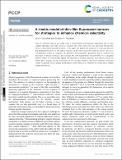Files in this item
A kinetic model of thin-film fluorescent sensors for strategies to enhance chemical selectivity
Item metadata
| dc.contributor.author | Campbell, Iain A. | |
| dc.contributor.author | Turnbull, Graham | |
| dc.date.accessioned | 2021-05-10T13:30:09Z | |
| dc.date.available | 2021-05-10T13:30:09Z | |
| dc.date.issued | 2021-05-14 | |
| dc.identifier | 273979477 | |
| dc.identifier | 0b7d62a7-8d3b-4fe7-abea-5cc983b76dd5 | |
| dc.identifier | 000645300600001 | |
| dc.identifier | 85106147442 | |
| dc.identifier.citation | Campbell , I A & Turnbull , G 2021 , ' A kinetic model of thin-film fluorescent sensors for strategies to enhance chemical selectivity ' , Physical Chemistry Chemical Physics , vol. 23 , no. 18 , pp. 10791-10798 . https://doi.org/10.1039/D1CP00835H | en |
| dc.identifier.issn | 1463-9076 | |
| dc.identifier.uri | https://hdl.handle.net/10023/23140 | |
| dc.description | Auhtors acknowledge funding from the Engineering and Physical Sciences Research Council grant number EP/N509759/1 and we also acknowledge funding from NATO Science for Peace & Security under grant agreement MYP G5355. | en |
| dc.description.abstract | Thin film chemical sensors are widely used in environmental and industrial applications due to their scalable fabrication and high sensitivity, however they often suffer from low specificity limiting their ability to discriminate between analytes. In this paper we analyse the influence of molecular diffusion and binding interactions on the optical response of thin film fluorescent chemical sensors. We use a computational model to calculate the dynamics of fluorescence quenching due to sorption and desorption of analyte molecules, and compare this with experimental measurements of a conjugated polymer sensor for nitroaromatic vapour. We find that to increase selectivity, such sensors should use thinner films, analyses should concentrate on the recovery dynamics, and sensor materials should be chosen to provide sensor-analyte combinations where diffusion is hindered by strong sensor-analyte binding interactions. | |
| dc.format.extent | 4094062 | |
| dc.language.iso | eng | |
| dc.relation.ispartof | Physical Chemistry Chemical Physics | en |
| dc.subject | QC Physics | en |
| dc.subject | DAS | en |
| dc.subject.lcc | QC | en |
| dc.title | A kinetic model of thin-film fluorescent sensors for strategies to enhance chemical selectivity | en |
| dc.type | Journal article | en |
| dc.contributor.sponsor | NATO | en |
| dc.contributor.institution | University of St Andrews. School of Physics and Astronomy | en |
| dc.contributor.institution | University of St Andrews. Sir James Mackenzie Institute for Early Diagnosis | en |
| dc.contributor.institution | University of St Andrews. Centre for Biophotonics | en |
| dc.identifier.doi | 10.1039/D1CP00835H | |
| dc.description.status | Peer reviewed | en |
| dc.identifier.grantnumber | MYP G5355 | en |
This item appears in the following Collection(s)
Items in the St Andrews Research Repository are protected by copyright, with all rights reserved, unless otherwise indicated.

